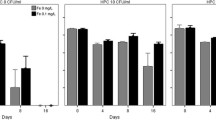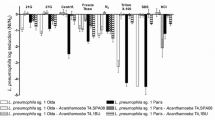Abstract
The aim of the present study is to determinein vitro inhibitory and/or stimulatory effects of different bacteria on concomitantLegio nella pneumophila. The interactions betweenLegionella and other bacteria were investigated by using bacteria culture and cell-free supernatants (CFSs) on Buffered Charcoal Yeast Extract agar (BCYEA) and/or in BCYEA lacking L-cysteine. Additionally, CFSs of non-Legionella bacteria that possess inhibitory effect onL. pneumophila were characterised using enzyme and heat treatments. The inhibition ratio of the CFSs and the cultures of Gram-negative rod bacteria (GNRB) and Gram-positive rod bacteria (GPRB) on the growth ofL. pneumophila strains were 26–47% and 33–67%, respectively, on BCYEA. It was detected that the cultures ofAeromonas hydrophila, Aeromonas spp. strain andBacillus pumilus stimulated the growth of one of the investigatedL. pneumophila strains, but their CFSs did not show any stimulatory effect. The results indicated that growth and multiplication of legionellae could be affected by different bacteria sharing the same habitat and the level of this effect varies among the species. To our knowledge, this is the first study which determined the inhibitory effects ofB. pumilus andBrevibacillus brevis againstLegionella. The biologically active substances produced by the bacteria could play an important role in the control ofL. pneumophila. This phenomenon may be used an alternative approach for controlling legionellae in man-made environments.
Similar content being viewed by others
References
Barja J.L., Lemos M.L., Toranzo A.E. (1989). Purification and characterization of an antibacterial substance produced by a marineAlteromonas species. Antimicrobial Agents and Chemotherapy, 33: 1674–1679.
Baskin H., Onal O., Kiratki H. (1998). A modification inLegionella pneumophila isolation from environmental water samples. Journal of the Turkish Microbiological Society, 28: 7–10.
Bevilacqua L., Ovidi M., Di Mattia E., Trovatelli L.D., Canganella F. (2003). Screening ofBifidobacterium strains isolated from human faeces for antagonistic activities against potentially bacterial pathogens. Microbiological Research, 158: 179–185.
Bohach G.A., Snyder I.S. (1983). Cyanobacterial stimulation of growth and oxygen uptake byLegionella pneumophila. Applied and Environment Microbiology, 46: 528–531.
Brenner D.J., Steigerwalt A.G., Epple P., Bibb W.F., McKinney R.M., Starnes R.W., Colville J.M., Selander R.K., Edelstein P.A., Moss C.W. (1988).Legionella pneumophila serogroup Lansing 3 isolated from a patient with fatal pneumonia, and descriptions ofL. pneumophila subsp.pneumophila subsp. nov.,L. pneumophila subsp.fraseri subsp. nov., andL. pneumophila subsp.pascullei subsp. nov. Journal of Clinical Microbiology, 26: 1695–1703.
British Standard (1998). Water Quality. Part 4: Microbiological Methods, Detection and Enumeration ofLegionella. BS 6068 — 4, 12:1998.
Cetinkaya S., Osmanoglu O., Cokmus C. (2003). Bacteriocin diversity inBacillus sphaericus. Folia Microbiologica, 48: 157–161.
Cotuk A., Dogruoz N., Zeybek Z., Kimiran-Erdem A., Ilhan-Sungur E. (2005). The effects ofPseudomonas andAeromonas strains onLegionella pneumophila growth. Annals of Microbiology, 55: 219–224.
Cladera-Olivera F., Caron G.R., Brandelli A. (2004). Bacteriocinlike substance production byBacillus licheniformis strain P40. Letters in Applied Microbiology, 38: 251–256.
Delgado-Viscogliosi P., Simonart T., Parent V., Marchand G., Dobbelaere M., Pierlot E., Pierzo V., Menard-Szczebara F., Gaudard-Ferveur E., Delabre K., Delattre J.M. (2005). Rapid method for enumeration of viableLegionella pneumophila and otherLegio nella spp. in water. Applied and Environment Microbiology, 71: 4086–4096.
Den Boer J.W., Verhoef L., Bencini M.A., Bruin J.P., Jansen R., Yzerman E.P.F. (2007). Outbreak detection and secondary prevention of Legionnaires’ disease: A national approach. International Journal of Hygiene and Environmental Health, 210: 1–7.
Fliermans C.B., Cherry W.B., Orrison L.H., Smith S., Tison D.L., Pope D.H. (1981). Ecological distribution ofLegionella pneumophila. Applied and Environmental Microbiology, 41: 9–16.
Gaetti-Jardim Jr. E., Avila-Campos M.J. (1999). Bacterioc inlike activity of oralFusobacterium nucleatum isolated from human and non-human primates. Revista de Microbiologia, 30: 342–346.
Gomez-Lus R., Lomba E., Gomez-Lus P., Abarca M.S., Gomez-Lus S., Martinez A., Duran E., Rubio M.C. (1993).In vitro antagonistic activity ofPseudomonas aeruginosa, Klebsiella pneumonie, Aeromonas spp. againstLegionella spp., In: Barbare J.M., Breiman R.F., Dufour A.P., Eds,Legionella Current Status and Emerging Perspectives, ASM Press, Washington D.C., 1-55581-055-1, pp. 265–267.
Hechard Y., Ferraz S., Bruneteau E., Steinert M., Berjeaud J.M. (2005). Isolation and characterization of aStaphylococcus warneri strain producing anti-Legionella peptide. FEMS Microbiology Letters, 252: 19–23.
Koide M., Miyata T., Nukina M., Teramoto T., Nakanishi H., Kamiki T., Umeda B., Nakai H. (1989). A strain ofPseudomonas vesicularis isolated from shower hose which supports the multiplication ofLegionella. Kansenshogaku Zasshi, 63: 1160–1164.
Laukova A. (2001). Effect of Enterocins Ccm4231 and V24 on the cells of environmental isolatesAcinetobacter spp. Acta Veterinaria Brno, 70: 473–477.
Lee K.H., Jun K.D., Kim W.S., Paik H.D. (2001). Partial characterization of polyfermenticin SCD, a newly identified bacteriocin ofBacillus polyfermenticus. Letters in Applied Microbiology, 32: 146–151.
Maillard J.Y. (2002). Bacterial target sites for biocide action. Journal of Applied Microbiology Symposium Supplement. 92: 16S-27S.
Paszko-Kolva C., Yamamoto H., Shahamat M., Sawyer T.K., Morris G., Colwell R.R. (1991). Isolation of amoebae andPseudomonas andLegionella spp. from eyewash station. Applied and Environmental Microbiology, 57: 163–167.
Riley M.A., Chavan M.A. (2007). Bacteriocins: Ecology and Evolution, ISBN-10: 3-540-36603-2, ISBN-13: 978-3-540-36603-4, pp. 1–4, Springer-Verlag Berlin Heidelberg.
Rokka S., Pihlanto A., Korhonen H., Joutsjoki V. (2006).In vitro growth inhibition ofHelicobacter pylori by lactobacilli belonging to theLactobacillus plantarum group. Letters in Applied Microbiology, 43: 508–513.
Sanli-Yürüdü N.O., Kimiran-Erdem A., Cotuk A. (2007). Studies on the efficacy of Chloramine T trihydrate (N-chloro-p-toluene sulfonamide) against planktonic and sessile populations of differentLegionella pneumophila strains. International Journal of Hygiene and Environmental Health, 210: 147–153.
Savadogo A., Quattara C.A.T., Bassole I.H.N., Traore A.S. (2004). Antimicrobial activities of lactic acid bacteria strains isolated fromBurkina Faso fermented milk. Pakistan Journal of Nutrition, 3: 174–179.
Surman S.B., Morton L.H.G., Keevil C.W. (1994). The dependence ofLegionella pneumophila on other aquatic bacteria for survival on R2A medium. International Biodeterioration and Biodegradation, 13: 223–236.
Stout J.E., Yu V.L., Best M.G. (1985). Ecology ofL. pneumophila within water distribution systems. Applied and Environmental Microbiology, 49: 221–228.
Stout J.E., Best M.G., Yu L.Y., Rihs J.D. (1986). A note on symbiosis ofLegionella pneumophila andTatlockia micdadei with human respiratory flora. Journal of Applied Bacteriology, 60: 297–299.
Tesh M.J., Miller R.M. (1981). Amino acid requirements forLegionella pneumophila growth. Journal of Clinical Microbiology, 13: 865–869.
Todorov S.D., Wachsman M.B., Knoetze H., Meincken M., Dicks L.M.T. (2005). An antibacterial and antiviral peptide produced byEnterococcus mundtii ST4V isolated from soya beans. International Journal of Antimicrobial Agents, 25: 508–513.
Toze S., Sly L.I., MacRae I.C., Fruerst J.A. (1990). Inhibition of growth ofLegionella species by heterotrophic plate count bacteria isolated from chlorinated drinking water. Current Microbiology, 21: 139–143.
Toze S., Sly L.I., Hayward C., Fuerst J. (1993). Bactericidal effect of inhibitory non-Legionella bacteria onLegionella pneumophila, In: Barbare J.M., Breiman R.F., Dufour A.P., Eds, Legionella Current Status and Emerging Perspectives, ASM Press, Washington D.C., 1-55581-055-1, pp. 269–273.
Türetgen I., Cotuk A. (2007). Monitoring of biofilm-associatedLegionella pneumophila on different substrata in model cooling tower system. Environmental Monitoring and Assessment, 125: 271–279.
Yamamoto H., Sugiura M., Kusunoki S., Ezaki T., Ikedo M., Yabuuchi E. (1992). Factors stimulating propagation ofLegionellae in cooling tower water. Applied and Environmental Microbiology, 58: 1394–1397.
Yokoyama E., Maruyama S., Katsube Y. (1998). Production of bakteriosin-like substance byListeria innocua againstListeria monocytogenes. Journal of Food Microbiology, 40: 133–137.
Wadowsky R.M., Yee R.B. (1983). Satellite growth ofL. pneumophila with an environmental isolate ofFlavobacterium breve. Applied and Environmental Microbiology, 46: 1447–1449.
Wadowsky R.M., Yee R.B. (1985). Effect of non-Legionellaceae bacteria on the multiplication ofLegionella pneumophila in potable water. Applied and Environmental Microbiology, 49: 1206–1210.
Wadowsky R.M., Butler L.J., Cook M.K., Verma S.M., Paul M.A., Fields B.S., Keleti G., Sykora J.L., Yee R.B. (1988). Growth-supporting activity forLegionella pneumophila in tap water cultures and implication of Hartmannellid Amo ebae as growth factors. Applied and Environmental Microbiology, 54: 2677–2682.
Yilmaz M., Soran H., Beyatli Y. (2006). Antimicrobial activities of someBacillus spp. strains isolated from the soil. Microbiological Research, 161: 127–131.
Zeybek Z., Kimiran A., Cotuk A. (2003). Distribution of bacteria causing Legionnaires’ disease at potable water in Istanbul. Biologia Bratislava, 58: 1023–1027.
Zeybek Z., Dogruoz, N., Cotuk, A. (2005).In vitro anti-Legionella activity of theBacillus strains. 6th Congress of the International Federation of Infection Control, Istanbul, 13–16 October 2005, p. 124.
Author information
Authors and Affiliations
Corresponding author
Rights and permissions
About this article
Cite this article
Erdem, A.K., Yazici, A. Anin vitro evaluation of the interactions ofLegionella pneumophila serogroups 2 to 14 strains with other bacteria in the same habitat. Ann. Microbiol. 58, 395–401 (2008). https://doi.org/10.1007/BF03175534
Received:
Accepted:
Issue Date:
DOI: https://doi.org/10.1007/BF03175534




